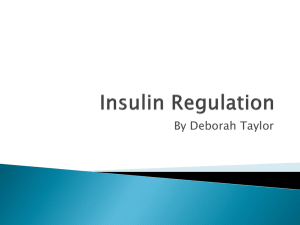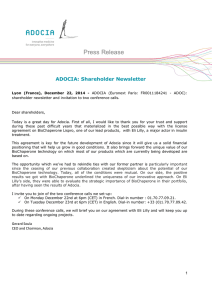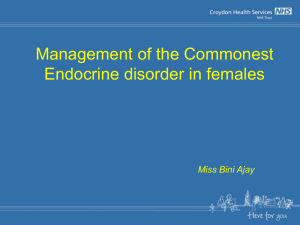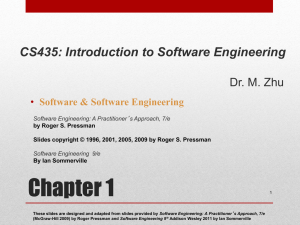Pendergrass- Insulin Therapy
advertisement
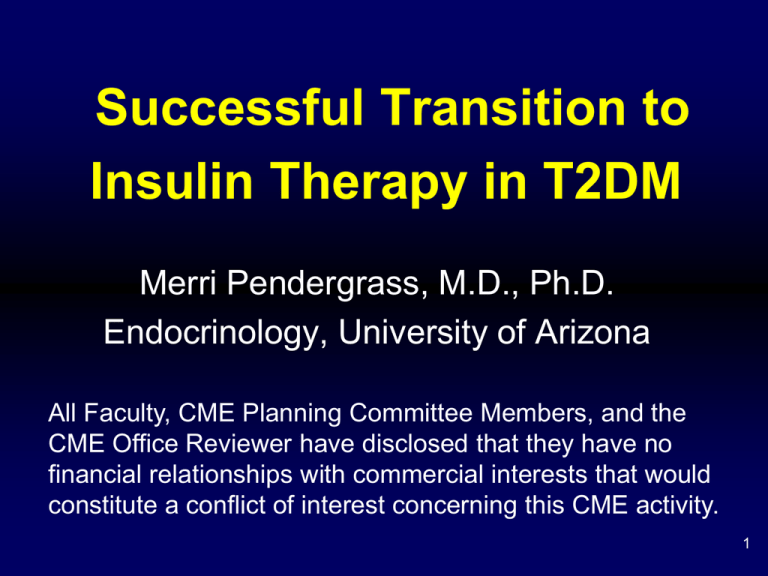
Successful Transition to Insulin Therapy in T2DM Merri Pendergrass, M.D., Ph.D. Endocrinology, University of Arizona All Faculty, CME Planning Committee Members, and the CME Office Reviewer have disclosed that they have no financial relationships with commercial interests that would constitute a conflict of interest concerning this CME activity. 1 Learning Objectives Participants should be better able to • Select a strategy for insulin initiation • Intensify an insulin regimen • Understand available modalities (e.g. vials, pens) for insulin administration 2 54 year old patient with T2DM • On metformin 1000 bid, glipizide 10 qd • A1C 9.1 What would you add now? a. b. c. d. e. Pioglitazone (Actos®) Exenatide (Byetta®) Sitagliptin (Januvia®) Canaglifozin (Invokana®) Insulin 3 54 year old patient with T2DM • On metformin 1000 bid, glipizide 10 qd • A1C 9.1 What would you add now? a. b. c. d. e. Pioglitazone (Actos®) Exenatide (Byetta®) Sitagliptin (Januvia®) Canaglifozin (Invokana®) Insulin 4 Approximate A1C Lowering ~ A1C Reduction (%) Metformin Sulfonylurea Avandia, Actos Byetta, Bydureon, Victoza Invokana Januvia,Onglyza,Tradjenta, Nesina 1.0-2.0 1.0-2.0 0.5-1.5 0.5-1.5 0.8-1.0 0.5-0.8 5 Insulin for Type 2 Diabetes • • • • Safe and effective option Not a last resort Can decrease any level of A1C to goal Indicated if not controlled on non-insulins 6 Improving Insulin Acceptance • Don’t threaten as a punishment • Address patient concerns/preconceptions, e.g. – Not a personal failure – Complications are not inevitable – Can potentially stop insulin later • Consider insulin pens 7 Profiles of Available Insulins NPH Detemir (Levemir) Glargine (Lantus) Regular Lispro (Humalog) Aspart (Novolog) Glulisine (Apidra) Insulin Effect Basal Bolus Nutritional Correction 0 6 12 18 24 Time (hours) 8 Which regimen will you start? a. b. c. d. NPH at bedtime Lantus® at bedtime NPH/regular bid ac NPH at bedtime + regular tid ac 9 Which regimen will you start? a. b. c. d. NPH at bedtime Lantus® at bedtime NPH/regular bid ac NPH at bedtime + regular tid ac 10 Same Effects in T2DM with Insulin Given QD, BID, or QID 2 Least weight gain 1 Change in 0 A1C (%) -1 -2 Control AM NPH HS NPH BID NPH QID N/R -0.5 -1.7 * -1.9 -1.8 * * Yki-Jarvinen H, et al. N Engl J Med. 1992;327:1426-1433. -1.6 * 11 Evidence Supports Initiating Insulin… Type NPH Glargine Detemir Lispro, aspart, glulisine Pre-mix Other combinations Regimen QD, BID TID QD, BID, TID QD, BID, TID, QID 12 Sequential Insulin Strategies in T2DM diabetes. Inzucchi S E et al. Dia Care 2012;35:1364-1379 Copyright © 2011 American Diabetes Association, Inc. Initiating Basal Insulin • ~50% patients achieve A1C< 7% with basal insulin given at bedtime • For T2DM, effects are similar for qHS – NPH – Glargine (Lantus®) – Detemir (Levemir®) $ $$ $$ 14 Insulin Cost* Item NPH NPH Lantus Lantus U500 10 ml vial Box of 5 (3 ml pens) 10 ml vial Box of 5 (3 ml pens) 20 ml vial Cost ($) $/1000 units / Item (~33 units/day) 24.88 24.88 294.28 226.68 351.62 196.18 226.68 234.41 1130.00 113.00 *Walmart 2/8/14 15 The Treat-to-Target Trial NPH vs. Glargine (Lantus®) Start With 10 IU Insulin qHS & Adjust Weekly Mean FBG on Increase in Insulin Preceding 2 Days Dosage > 180 140-180 8 6 120-140 100-120 4 2 Riddle et al, Diabetes Care 26, 3080-3086, 2003 16 qHS NPH and qHS Lantus® have Similar Effects on A1C, FPG (T2DM) Glargine (Lantus) NPH 9 A1C (%) FPG (mg/dl) 200 150 8 7 6 0 4 8 12 16 20 24 0 4 Riddle et al, Diabetes Care 26, 3080-3086, 2003 8 12 16 20 24 17 Slightly Less Hypoglycemia: with Glargine (Lantus) vs. NPH Number of events/patient/year NPH 20 15 Lantus * 17.7 13.9 10 * 5.1 5 3 * 2.5 1.8 0 < 72 mg/dl <56 mg/dl Riddle et al, Diabetes Care 26, 3080-3086, 2003 Severe Key Factor Contributing to the Success of the Regimen • • • • Not what type of insulin is used Not how many doses are used Not what is the initial starting dose Success depends on – Adherence – How regularly and rapidly insulin is adjusted to achieve targets! 19 20 21 Insulin Titration: MD Vs. Patients Start with 10 units glargine qHS Titrated by MD (N=2315) Titrated by Patient (N=2273) ≥ 100 to < 120 0-2* 0-2* ≥ 120 to < 140 2 2 ≥ 140 to < 180 4 2 ≥ 180 6-8 2 Diabetes Care 28:1282-1288, 2005 *Only increase if no values < 72 22 Patient and MD Insulin Titration Yield Similar Results MD Titration Patient Titration Baseline 24 Weeks 35 9 8.8 8.6 8.4 8.2 A1C (%) 8 7.8 7.6 7.4 7.2 7 30 25 Incidence of 20 Hypoglycemia 15 (%) 10 5 0 MD Titration Patient Titration Severe Symptomatic Nocturnal Diabetes Care 28:1282-1288, 2005 23 Question: • Patient on metformin, NPH 60 hs • A1C 8.0 • SMBG – Ac breakfast 80-100 – Ac lunch 80-100 – Ac dinner 80-120 – HS 200-250 What would you do? a. Change from NPH to glargine (Lantus) b. Increase NPH to 70 c. Add NPH in AM d. Add lispro (Humalog) ac dinner 24 Question: • Patient on metformin, NPH 60 hs • A1C 8.0 • SMBG – Ac breakfast 80-100 – Ac lunch 80-100 – Ac dinner 80-120 – HS 200-250 What would you do? a. Change from NPH to glargine (Lantus) b. Increase NPH to 70 c. Add NPH in AM d. Add lispro (Humalog) ac dinner 25 Patient now on metformin, insulin Would NOT change NPHglargine: (glargine = NPH for A1C changes) • Meds: metformin 1 g bid, NPH 60 hs • A1C 8.0 Would NOT increase NPH HS (risk for AM • SMBG hypoglycemia) – Before breakfast – Before lunch – Before dinner – Before bedtime 80-100 80-100 80-120 200-250 Would NOT Add NPH AM (risk for daytime hypoglycemia) Best to add rapid-acting insulin ac dinner 26 Matching Insulin to Basal and Nutritional Needs 8 12 6 10 27 50 year old patient with T2DM, BMI 40.1, A1C 12, FPG 250, Metformin 1 g bid, 70/30 100 bid What is your next step? a) b) c) d) Increase to 70/30, 150 bid Increase to 70/30, 100 tid Split each dose into 2 injections Stop 70/30, start U-500 regular insulin 50 year old patient with T2DM, BMI 40.1, A1C 12, FPG 250, Metformin 1 g bid, 70/30 100 bid What is your next step? a) b) c) d) Increase to 70/30, 150 bid Increase to 70/30, 100 tid Split each dose into 2 injections Stop 70/30, start U-500 regular insulin Strategies to Get “More Insulin Into” Insulin Resistant Patients • Add additional injections, e.g. 70/30 three time a day • Split large doses into 2 injections (smaller depot = better absorption) • Use more concentrated insulins, e.g. U-500 30 U-500 is Five Times as Concentrated as U-100 Insulin • • • • U-100 = 100 units/ml U-500 = 500 units/ml 1 ml U-100 = 100 units = 0.2 ml U-500 U-500 should be considered when total daily dose (TDD) insulin is > 200 units • Initial dosing ~ BID ENDOCRINE PRACTICE Vol 15 No. 1 January/February 2009 31 U500 Lets Patient Inject Less 100 units u100 100 units u500 32 Convert Insulin Units U-500 cc: Divide Units by 500 125 units insulin = ?? cc u500 125 units insulin 1 cc .25 cc 500 units insulin 150 units insulin = 150 / 500 = .30 cc 175 units insulin = 175 / 500 = .35 cc 33 Convert U-500 cc Units Insulin: Multiply cc by 500 .30 cc u500 = ?? units insulin .30 cc u500 500 units insulin 1 cc u500 150 units insulin .35 cc u500 = .35 X 500 = 175 units .15 cc u500 = .15 X 500 = 75 units 34 Include Two Identifiers of Correct Dose on Prescriptions 35 Better Control with u500 N = 53, 6-52 months f/u A1C (%) Insulin dose (units) Weight (kg) Cholesterol (mg/dL) TG (mg/dL) Severe hypoglycemia (total events in first 12 months f/u) Endocr Pract. 2011 Jul 8:1-15. Baseline End (u-100) (u-500) 9.1 8.1* 391 415* 134 136 176 156* 349 252* 3 3 * P < 0.05 36 Additional Insulin Concentrations May Become Available Soon • Insulin degludec (TresibaTM) – Approved in the EU and Japan – Under regulatory review in the US – Developed both as a 100-unit/ml formulation and a 200-unit/ml formulation 37 70/30 Effective When Given Once, Twice, or Thrice a Day 90 80 70 60 Percentage 50 of Patients with A1C<7 40 30 20 70 77 41 10 0 QD BID Diabetes, Obesity and Metabolism, 8, 2006, 58–66 TID 38 Splitting Large Volume into Two Injection Sites May Improve Effect Depots more than ~ .6 ml not well absorbed 100 units (1.0 ml) 50 units (0.5 ml) 50 units (o.5 ml) Better Absorption 39 High Dose Insulin More Effective Injected in Two vs. One Site 11 10.5 10 9.5 A1C (%) 9 8.5 10 10.4 8 Baseline 12months 10.3 8.8 7.5 7 1-site injection (240 IU) 2-site injection (254 IU) Saryusz-Wolska M. Abstract #109. EASD; Sept. 12-16, 2011; Lisbon. 40 Ordering Insulin and Supplies Examples for 90-Day Supply Vial/syringe = 2 scripts 1. NPH 50 units SC qHS, Disp: 5 vials 2. Syringes, 1 ML 6 MM (15/64”) X 31 G, 100count box 90 days X 50 units/day X 1 vial/1000 units = 4.5 vials Shorter, thinner needles hurt less! 41 Ordering Insulin and Supplies Examples for 90-Day Supply Pen/needles = 2 scripts 300 units 1. NPH 50 units SC qHS, Disp: 3 boxes (5 X 3 mL) 2. Pen needles, 4mm x 32G, 100-count box 42 Recommendations - 1 • Start with a single injection of basal insulin at bedtime – NPH has lowest cost and similar clinical effects as Lantus® and Levemir® – Insulin pens easier but more expensive • Titrate insulin often to normalize FBG 43 Recommendations - 2 • If FBG at goal (~100) and A1C above goal, add an injection of a short-acting insulin before the largest meal – Regular is cheapest but adherence may be better with Humalog®, Novolog® or Apidra® • Consider adding additional pre-meal injections, based on BG monitoring 44 Recommendations - 3 • Continue metformin • Stop sulfonylureas if insulin dose is more than ~20-40 units • Consider potential risks and benefits of continuing other non-insulin agents, e.g. – Multiple agents can get expensive – Not much incremental A1C benefit – Invokana®, Byetta®, Victoza® associated with weight loss 45 Recommendations - 4 • If A1C is above goal with > 200 units of insulin per day, consider switching to U-500 bid 46 Comments or Questions? mpendergrass@deptofmed.arizona.edu 47



